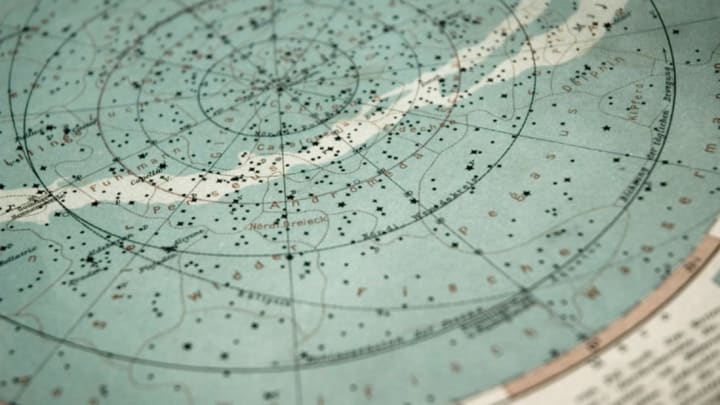Astronomer or not, you probably have a rudimentary knowledge of the planets in our Solar System. But even what you learned in elementary school might be out of date. Thanks to the data regularly flowing in from satellites, space probes, and telescopes, what we know about the planets is constantly being reshaped. But this trend is no recent thing: Humans have been making observations of the heavens for millennia, and in that time people have said a lot of different things about the planets. Here are a few that are more inaccurate than astute.
1. THE ANCIENT GREEKS THOUGHT PLANETS WERE STARS.
The Ancient Greeks called the planets asteres planetai, or “wandering stars,” due to their changing positions in the night sky. The wandering stars included not only the traditionally visible planets of our solar system (Mercury, Venus, Mars, Jupiter, and Saturn) but also the Sun and the Moon, which the Greeks dubbed the “classical planets.” The seven classical planets were thought to be of the same fiery composition, called aether, as the stars, differing only in their appearance and heavenly motion—a belief which held until the planets were observed by telescope.
Despite having a fairly inaccurate understanding of the nature of these celestial objects, ancient astronomers were able to calculate their orbital periods and predict their future positions to nearly that of modern calculations. (In fact, many modern planetariums still rely on the Ptolemy method, developed in Ancient Greece, because it's so reliable.)
2. VENUS WAS THOUGHT TO BE TWO PLANETS INSTEAD OF ONE.
This stemmed from Ancient Greek astronomers seeing Venus just before the Sun rose, and just after the Sun set—leading them to name the two theorized stars Phosphorus and Hesperus, “Light-Bearer” and “Evening-Bearer.” (Their Latin names, Lucifer and Vesper, might be more familiar). Worthy of note was that the astronomical experts that were the Babylonians were never confused about Venus’ nature as one celestial body—a fact the Greeks later accepted.
3. THE ANCIENT EGYPTIANS THOUGHT MARS MOVED BACKWARDS.
We know that Mars orbits in the same direction as all the other planets, but every two years, Mars does appear to move backwards for a while. This is an illusion: Earth orbits the Sun in about half the time of Mars, meaning every 26 months, Earth passes Mars from behind and causes what appears to be a retrograde motion.
The Ancient Egyptians were adept astronomers, and by the second millennium BCE they had noticed Mars’ peculiar movement. This is evidenced by the unique treatment Mars received in the oldest known star map, which was discovered by Herbert Winlock between 1925-1927 in the tomb of Senenmut, an Egyptian government official of the 18th Dynasty. The Senenmut star map, which depicts an event in 1534 BCE, depicts Jupiter, Saturn, Mercury and Venus in together in one group as human-like entities standing on boats—but Mars is depicted on the other side of the map as nothing more than an empty boat. It would seem as if this were an indication of its unique behavior in the sky, perhaps an indication that Mars’ position was not “concrete.” A full scan of the Senenmut star map is available from the Metropolitan Museum of Art.
4. THE EARTH WAS THE CENTER OF THE UNIVERSE.
Click to enlarge
In the Almagest (circa the second century CE), the Greek astronomer Ptolemy standardized the geocentric model of the universe which had been created piecemeal by his predecessors. In the geocentric model the Earth was conceived of as the dense, unmoving center of the galaxy. This model wasn't replaced by the modern heliocentric model until the publishing of Nicolas Copernicus’ De Revolutionibus in 1543 CE, meaning the Earth was not recognized to be a planet until the 16th century. Even still, the acceptance of Earth’s status as a planet was a slow process, as it was not until the 18th century that the Church relented in its opposition to the heliocentric system (which occurred just before Uranus was discovered; more on that below).
5. URANUS WAS INITIALLY THOUGHT TO BE A COMET.
Uranus had been observed on several occasions before its classification as a planet, but its historically defined “discovery” occurred in 1781, when William Herschel accidentally classified it as a comet. The explanation for this lack of recognition is quite simple: Despite being visible, its brightness doesn't stand out against the hundreds of thousands of stars in the sky, and you need to observe it for a long time to see any motion against the stars. By 1783, though, the findings of astronomers Johann Elert Bode and Anders Johan Lexell forced Herschel into admitting to the Royal Society of London that Uranus was indeed a planet.
6. EARTH WAS THOUGHT TO HAVE A TWIN.
Following the teachings of Pythagoras (yes, that guy with the Theorem), Philolaus, in the 5th century BCE, posited the Earth and planets revolved around a "central fire.” Despite this sounding like the heliocentric model, the Sun was thought to orbit this “central fire” as well, reflecting its light onto Earth like a mirror. Earth was also thought to be tidally locked with the aforementioned central fire, which meant that Earth always had the same side facing towards it, while the Greek side faced out.
Yet Philolaus couldn't accept that the Earth could be the only dense, rocky thing in a galaxy full of weightless lights, so he theorized that a “Counter-Earth” existed to balance the weight of the galaxy. To explain why the Counter-Earth was not visible from Earth, he placed it 180 degrees opposite the Earth on the other side of the "central fire” and made its orbit equal to Earth’s. Despite being a great source for allegory and fiction, though, the Counter-Earth theory had been dismissed by the time Ptolemy came along.
